地点介词
- 格式:ppt
- 大小:3.34 MB
- 文档页数:42
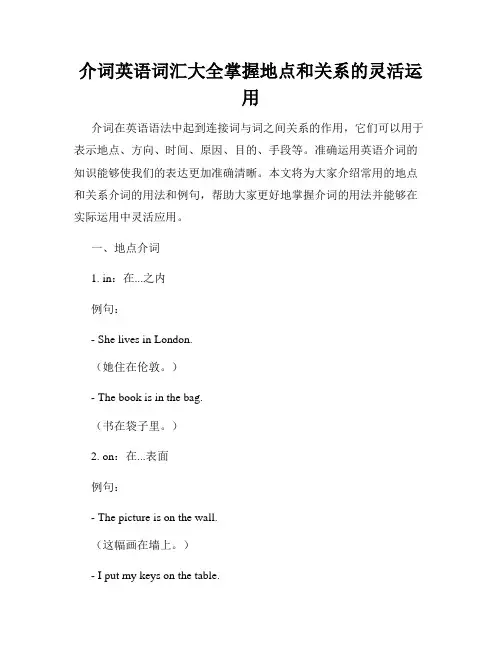
介词英语词汇大全掌握地点和关系的灵活运用介词在英语语法中起到连接词与词之间关系的作用,它们可以用于表示地点、方向、时间、原因、目的、手段等。
准确运用英语介词的知识能够使我们的表达更加准确清晰。
本文将为大家介绍常用的地点和关系介词的用法和例句,帮助大家更好地掌握介词的用法并能够在实际运用中灵活应用。
一、地点介词1. in:在...之内例句:- She lives in London.(她住在伦敦。
)- The book is in the bag.(书在袋子里。
)2. on:在...表面例句:- The picture is on the wall.(这幅画在墙上。
)- I put my keys on the table.(我把钥匙放在桌子上。
)3. at:在...的位置/地点例句:- We meet at the park every Sunday.(我们每个星期天在公园见面。
)- The meeting is at 8 o'clock.(会议在8点举行。
)4. under:在...下面例句:- The cat is sleeping under the table.(猫正在桌子下面睡觉。
)- The book is under the bed.(书在床下。
)5. beside:在...旁边例句:- There is a tree beside the house.(房子旁边有一棵树。
)- She sat beside me during the concert.(演唱会期间她坐在我旁边。
)6. between:在...之间例句:- The library is between the school and the bank.(图书馆在学校和银行之间。
)- She couldn't decide between the blue dress and the red one.(她无法决定穿蓝裙子还是红裙子。
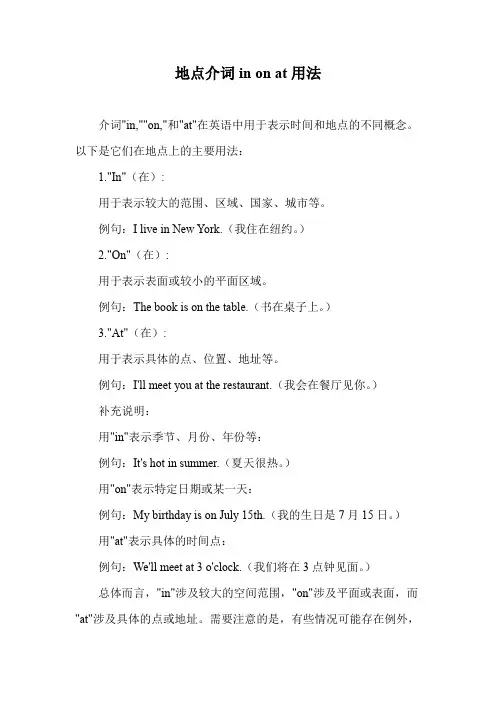
地点介词in on at用法
介词"in,""on,"和"at"在英语中用于表示时间和地点的不同概念。
以下是它们在地点上的主要用法:
1."In"(在):
用于表示较大的范围、区域、国家、城市等。
例句:I live in New York.(我住在纽约。
)
2."On"(在):
用于表示表面或较小的平面区域。
例句:The book is on the table.(书在桌子上。
)
3."At"(在):
用于表示具体的点、位置、地址等。
例句:I'll meet you at the restaurant.(我会在餐厅见你。
)
补充说明:
用"in"表示季节、月份、年份等:
例句:It's hot in summer.(夏天很热。
)
用"on"表示特定日期或某一天:
例句:My birthday is on July 15th.(我的生日是7月15日。
)
用"at"表示具体的时间点:
例句:We'll meet at 3 o'clock.(我们将在3点钟见面。
)
总体而言,"in"涉及较大的空间范围,"on"涉及平面或表面,而"at"涉及具体的点或地址。
需要注意的是,有些情况可能存在例外,
因此在具体语境中仍需谨慎使用。
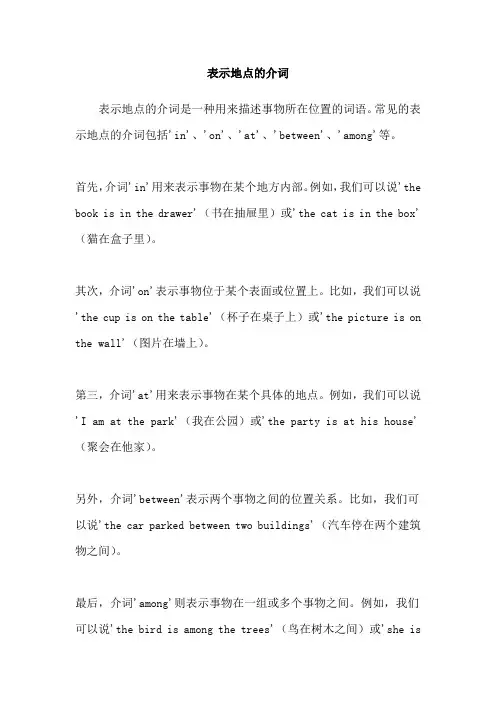
表示地点的介词表示地点的介词是一种用来描述事物所在位置的词语。
常见的表示地点的介词包括'in'、'on'、'at'、'between'、'among'等。
首先,介词'in'用来表示事物在某个地方内部。
例如,我们可以说'the book is in the drawer'(书在抽屉里)或'the cat is in the box'(猫在盒子里)。
其次,介词'on'表示事物位于某个表面或位置上。
比如,我们可以说'the cup is on the table'(杯子在桌子上)或'the picture is on the wall'(图片在墙上)。
第三,介词'at'用来表示事物在某个具体的地点。
例如,我们可以说'I am at the park'(我在公园)或'the party is at his house'(聚会在他家)。
另外,介词'between'表示两个事物之间的位置关系。
比如,我们可以说'the car parked between two buildings'(汽车停在两个建筑物之间)。
最后,介词'among'则表示事物在一组或多个事物之间。
例如,我们可以说'the bird is among the trees'(鸟在树木之间)或'she isamong friends'(她在朋友中间)。
除了上述介词,还有其他表示地点的介词,如'under'(在...下面)、'over'(在...上面)、'beside'(在...旁边)等,它们都有不同的用法和含义。
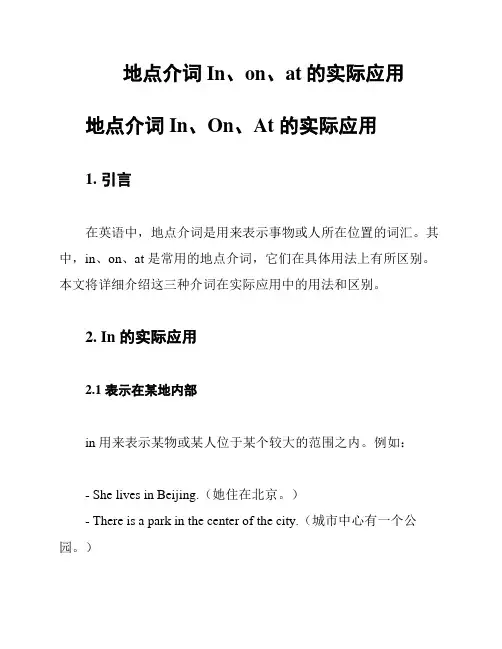
地点介词In、on、at的实际应用地点介词 In、On、At 的实际应用1. 引言在英语中,地点介词是用来表示事物或人所在位置的词汇。
其中,in、on、at 是常用的地点介词,它们在具体用法上有所区别。
本文将详细介绍这三种介词在实际应用中的用法和区别。
2. In 的实际应用2.1 表示在某地内部in 用来表示某物或某人位于某个较大的范围之内。
例如:- She lives in Beijing.(她住在北京。
)- There is a park in the center of the city.(城市中心有一个公园。
)2.2 表示在某地的某个具体区域in 还可以表示在某地的某个具体区域,如街道、街区等。
例如:- He works in Wangjing, Beijing.(他在北京旺京工作。
)- There are many restaurants in the downtown area.(市区有很多餐厅。
)2.3 表示在某地的一个较大范围in 还可以用来表示在某地的一个较大范围,如城市、国家等。
例如:- I have been to many cities in China.(我去过中国的许多城市。
)- She is traveling in Europe this year.(她今年在欧洲旅行。
)3. On 的实际应用3.1 表示在某地的表面on 用来表示某物位于某地的表面。
例如:- There is a book on the table.(桌子上有一本书。
)- The map is on the wall.(地图挂在墙上。
)3.2 表示在某地的一侧on 还可以用来表示在某地的一侧,如街道、河流等。
例如:- The restaurant is on the left side of the street.(餐厅在街道的左侧。
)- The river is on the east of the city.(河流在城市东部。
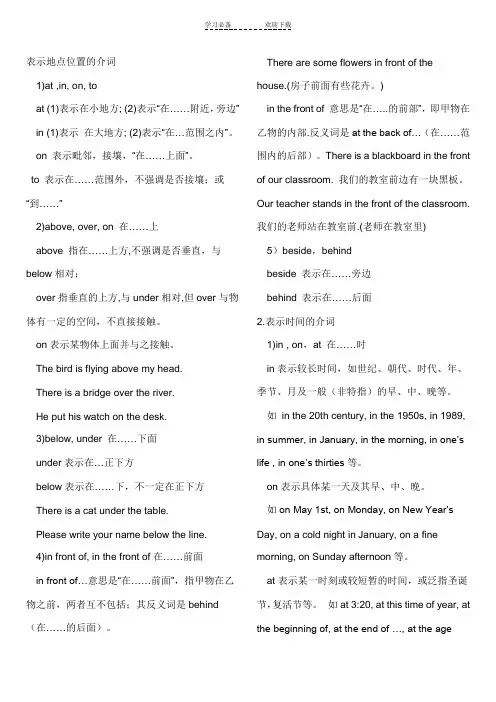
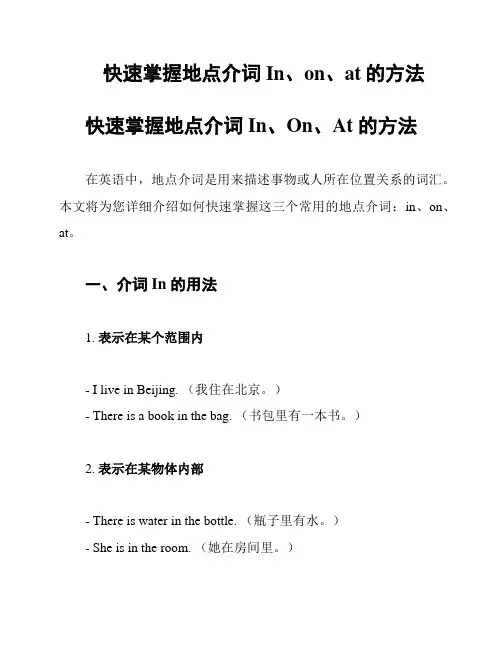
快速掌握地点介词In、on、at的方法快速掌握地点介词 In、On、At 的方法在英语中,地点介词是用来描述事物或人所在位置关系的词汇。
本文将为您详细介绍如何快速掌握这三个常用的地点介词:in、on、at。
一、介词 In 的用法1. 表示在某个范围内- I live in Beijing. (我住在北京。
)- There is a book in the bag. (书包里有一本书。
)2. 表示在某物体内部- There is water in the bottle. (瓶子里有水。
)- She is in the room. (她在房间里。
)二、介词 On 的用法1. 表示在某物体的表面上- There is a book on the table. (桌子上有一本书。
)- He put the cake on the plate. (他把蛋糕放在盘子上。
)2. 表示在某物体上部- There is a cat on the roof. (屋顶上有一只猫。
)三、介词 At 的用法1. 表示在某个特定点上- I will meet you at the airport. (我在机场等你。
)- She lives at No. 10 Downing Street. (她住在唐宁街10号。
)2. 表示时间点- I will call you at 8 o'clock. (我在8点给你打电话。
)总结通过以上详细解析,我们可以总结出:- In用于表示在某范围内或某物体内部。
- On用于表示在某物体的表面或上部。
- At用于表示某个特定点或时间点。
希望这份文档能帮助您快速掌握这三个地点介词的用法。
在日常英语交流中,灵活运用这些介词,能够更准确地描述事物或人的位置关系。
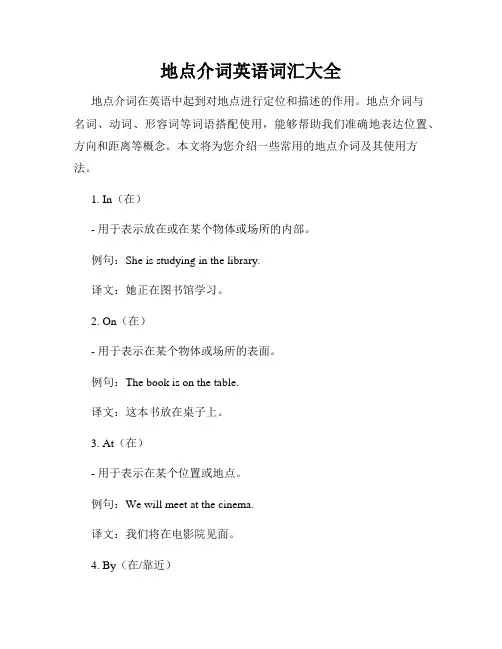
地点介词英语词汇大全地点介词在英语中起到对地点进行定位和描述的作用。
地点介词与名词、动词、形容词等词语搭配使用,能够帮助我们准确地表达位置、方向和距离等概念。
本文将为您介绍一些常用的地点介词及其使用方法。
1. In(在)- 用于表示放在或在某个物体或场所的内部。
例句:She is studying in the library.译文:她正在图书馆学习。
2. On(在)- 用于表示在某个物体或场所的表面。
例句:The book is on the table.译文:这本书放在桌子上。
3. At(在)- 用于表示在某个位置或地点。
例句:We will meet at the cinema.译文:我们将在电影院见面。
4. By(在/靠近)- 用于表示在某个物体或场所的旁边或附近。
例句:The bus stop is by the supermarket.译文:公交车站在超市旁边。
5. Under(在/在下面)- 用于表示在某个物体或场所的下方或底部。
例句:The cat is sleeping under the table.译文:猫正在桌子下面睡觉。
6. Over(在/在上方)- 用于表示在某个物体或场所的上方或顶部。
例句:There is a lamp over the bed.译文:床上方有一盏灯。
7. Between(在/在中间)- 用于表示在两个或多个物体或场所之间。
例句:The school is between the park and the hospital.译文:学校在公园和医院之间。
8. Behind(在/在后面)- 用于表示在某个物体或场所的后方。
例句:The car is parked behind the house.译文:车停在房子后面。
9. In front of(在/在前面)- 用于表示在某个物体或场所的前方。
例句:The playground is in front of the school.译文:操场在学校前面。
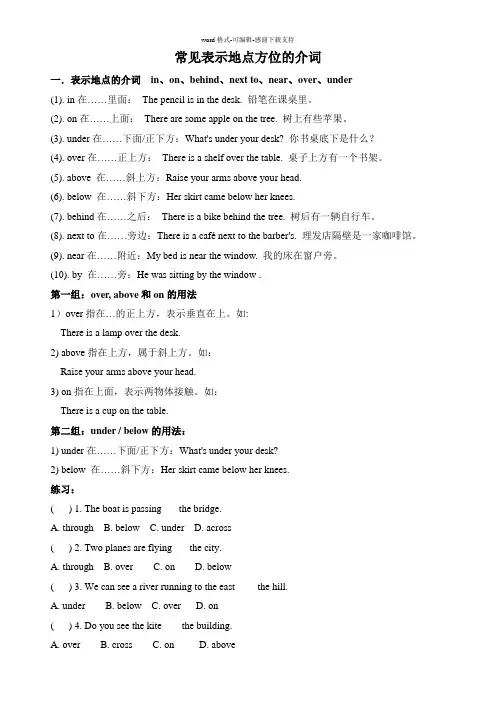
常见表示地点方位的介词一.表示地点的介词in、on、behind、next to、near、over、under(1). in在……里面:The pencil is in the desk. 铅笔在课桌里。
(2). on在……上面:There are some apple on the tree. 树上有些苹果。
(3). under在……下面/正下方:What's under your desk? 你书桌底下是什么?(4). over在……正上方:There is a shelf over the table. 桌子上方有一个书架。
(5). above 在……斜上方:Raise your arms above your head.(6). below 在……斜下方:Her skirt came below her knees.(7). behind在……之后:There is a bike behind the tree. 树后有一辆自行车。
(8). next to在……旁边:There is a café next to the barber's. 理发店隔壁是一家咖啡馆。
(9). near在……附近:My bed is near the window. 我的床在窗户旁。
(10). by 在……旁:He was sitting by the window .第一组:over, above和on的用法1)over指在…的正上方,表示垂直在上。
如:There is a lamp over the desk.2) above指在上方,属于斜上方。
如:Raise your arms above your head.3) on指在上面,表示两物体接触。
如:There is a cup on the table.第二组:under / below的用法:1) under在……下面/正下方:What's under your desk?2) below 在……斜下方:Her skirt came below her knees.练习:( ) 1. The boat is passing___ the bridge.A. throughB. belowC. underD. across( ) 2. Two planes are flying___ the city.A. throughB. overC. onD. below( ) 3. We can see a river running to the east____ the hill.A. underB. belowC. overD. on( ) 4. Do you see the kite ___ the building.A. overB. crossC. onD. aboveC B B D第三组:in 和on表示“在……上”1. 门一类——镶嵌在墙里的,用in,字画一类——挂在墙面上的,用on( ) 1. He put up a map ___ the back wall because there was a hole ___ it.A. on; onB. at; inC. on; inD. on; at( ) 2. There is a door___ the wall.A. onB. toC. ofD.in( ) 3. Any man ___ eyes______ his head can see that he's exactly like a rope.A. with; onB. with; inC. on; withD. in; with2. 鸟一类落在树上的,用in;苹果一类长在树上的,用on( ) 1. There are some birds singing___ the trees.A. inB. onC. atD. from( ) 2. There are so many apples___ that tree.A. inB. onC. atD. from第四组:in /on/ to表示“接壤”B A B A B AB 在A里—用in A和B相邻(接壤)—用on A和B不相邻(不接壤)—用to ( ) 1. The United States is ____ the south of Canada and ___ the east of Japan.A. to; inB. on; toC. in; besideD. at; on( ) 2. The man stood____the window, watching the boys playing outside.A. inB. byC. withD. to( ) 3. Japan lies____ the east of China.A. onB. toC. inD. withB B BB第五组:at, in表示“在……”1) at表示较小的地点。
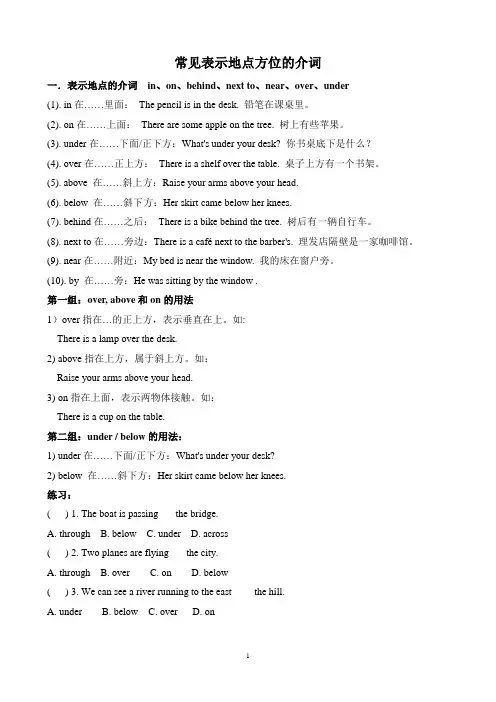
常见表示地点方位的介词一.表示地点的介词in、on、behind、next to、near、over、under(1). in在……里面:The pencil is in the desk. 铅笔在课桌里。
(2). on在……上面:There are some apple on the tree. 树上有些苹果。
(3). under在……下面/正下方:What's under your desk? 你书桌底下是什么?(4). over在……正上方:There is a shelf over the table. 桌子上方有一个书架。
(5). above 在……斜上方:Raise your arms above your head.(6). below 在……斜下方:Her skirt came below her knees.(7). behind在……之后:There is a bike behind the tree. 树后有一辆自行车。
(8). next to在……旁边:There is a café next to the barber's. 理发店隔壁是一家咖啡馆。
(9). near在……附近:My bed is near the window. 我的床在窗户旁。
(10). by 在……旁:He was sitting by the window .第一组:over, above和on的用法1)over指在…的正上方,表示垂直在上。
如:There is a lamp over the desk.2) above指在上方,属于斜上方。
如:Raise your arms above your head.3) on指在上面,表示两物体接触。
如:There is a cup on the table.第二组:under / below的用法:1) under在……下面/正下方:What's under your desk?2) below 在……斜下方:Her skirt came below her knees.练习:( ) 1. The boat is passing___ the bridge.A. throughB. belowC. underD. across( ) 2. Two planes are flying___ the city.A. throughB. overC. onD. below( ) 3. We can see a river running to the east____ the hill.A. underB. belowC. overD. on( ) 4. Do you see the kite ___ the building.A. overB. crossC. onD. aboveC B B D第三组:in 和on表示“在……上”1. 门一类——镶嵌在墙里的,用in,字画一类——挂在墙面上的,用on( ) 1. He put up a map ___ the back wall because there was a hole ___ it.A. on; onB. at; inC. on; inD. on; at( ) 2. There is a door___ the wall.A. onB. toC. ofD.in( ) 3. Any man ___ eyes______ his head can see that he's exactly like a rope.A. with; onB. with; inC. on; withD. in; with2. 鸟一类落在树上的,用in;苹果一类长在树上的,用on( ) 1. There are some birds singing___ the trees.A. inB. onC. atD. from( ) 2. There are so many apples___ that tree.A. inB. onC. atD. from第四组:in /on/ to表示“接壤”B A B A B AB 在A里—用in A和B相邻(接壤)—用on A和B不相邻(不接壤)—用to ( ) 1. The United States is ____ the south of Canada and ___ the east of Japan.A. to; inB. on; toC. in; besideD. at; on( ) 2. The man stood____the window, watching the boys playing outside.A. inB. byC. withD. to( ) 3. Japan lies____ the east of China.A. onB. toC. inD. with第五组:at, in表示“在……”1) at表示较小的地点。
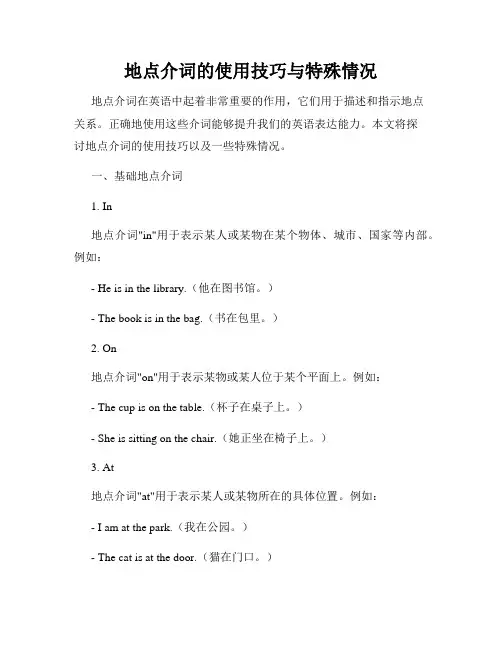
地点介词的使用技巧与特殊情况地点介词在英语中起着非常重要的作用,它们用于描述和指示地点关系。
正确地使用这些介词能够提升我们的英语表达能力。
本文将探讨地点介词的使用技巧以及一些特殊情况。
一、基础地点介词1. In地点介词"in"用于表示某人或某物在某个物体、城市、国家等内部。
例如:- He is in the library.(他在图书馆。
)- The book is in the bag.(书在包里。
)2. On地点介词"on"用于表示某物或某人位于某个平面上。
例如:- The cup is on the table.(杯子在桌子上。
)- She is sitting on the chair.(她正坐在椅子上。
)3. At地点介词"at"用于表示某人或某物所在的具体位置。
例如:- I am at the park.(我在公园。
)- The cat is at the door.(猫在门口。
)二、特殊情况1. 表示街道、路线和交通工具当我们谈论街道、路线和乘坐交通工具时,我们使用不同的介词来描述位置和移动方向。
a) On我们使用"on"来表示在公共交通工具上,例如:- I am on the bus.(我在公共汽车上。
)- She is on the train.(她在火车上。
)b) In我们使用"in"来表示在私人交通工具中,例如:- They are in the car.(他们在车里。
)- He is in the taxi.(他在出租车里。
)c) Along我们使用"along"来表示沿着街道或路线,例如:- We walked along the street.(我们沿着街道走。
)- He cycled along the bike path.(他沿着自行车道骑行。
)2. 表示建筑物和地点在谈论建筑物和地点时,我们需要根据具体情况选择合适的介词。

地点介词的用法总结介词是英语语法中非常重要的一部分,它用于表达地点、时间、原因等概念。
本文将总结并阐述地点介词的用法,帮助您更好地理解和运用。
首先,我们来介绍几个常见的地点介词。
1. 在 (in/on/at):- 在 (in) 用于表示在较大的区域或封闭区域内,如城市、国家、建筑物等。
例如:我在中国上大学。
(I study in China.)- 在 (on) 用于表示在平面或表面之上。
例如:杯子在桌子上。
(The cup is on the table.)- 在 (at) 用于表示在某个具体的位置或地方。
例如:我在图书馆学习。
(Istudy at the library.)2. 在前面 (in front of):在前面 (in front of) 用于表示在某物之前的位置。
例如:她站在我前面。
(Sheis standing in front of me.)3. 在后面 (behind):在后面 (behind) 用于表示在某物之后的位置。
例如:书架在桌子后面。
(The bookshelf is behind the table.)4. 在旁边 (next to/beside):在旁边(next to/beside) 用于表示在某物的旁边或附近。
例如:他坐在我旁边。
(He is sitting next to me.)5. 在里面 (inside):在里面 (inside) 用于表示在某物的内部。
例如:猫睡在篮子里面。
(The cat is sleeping inside the basket.)除了以上的常见介词外,还有一些特殊的地点介词:1. 在上面 (above/on top of):在上面 (above/on top of) 用于表示在某物的顶部或上方位置。
例如:鸟飞在树上面。
(The bird is flying above the tree.)2. 在下面 (below/underneath/under):在下面 (below/underneath/under) 用于表示在某物的底部或下方位置。
地点介词主要有 at ,in, on, to, above , over,below, under, beside,behind , between。
它们的用法具体如下:( 1 ) at 通常指小地方: In the afternoon , he finally arrived at home 。
到下午他终于到家了。
( 2 )at 通常所指范围不太明显,表示“在……附近,旁边”:Theball is at thecorner 。
球搁在角落里。
( 1 ) in 通常指大地方: When I was young , I lived in Beijing 。
我小时候住在北京。
( 2 )在内部: There is a ball in in the box 。
盒子里有只球。
( 3 )表示“在…范围之内” (是从属关系):Guangdong lies in the south of China 。
深圳在中国的南部。
( 1 ) on 主要指“在……之上”,强调和表面接触:There is a book on the table 。
桌上有一本书。
( 2 )表示毗邻,接壤(是相邻关系) :Canada lies on the north of America 加拿大在美国的北边(与美国接壤)。
主要表示“在……范围外”,强调不接壤,不相邻。
Japan is to the east of China 。
日本在中国的东面。
注意:( 1 ) at 强调“点”,on 强调“面”,in 强调“在里面”,to 表示“范围外”。
( 2 ) on the tree :表示树上本身所长着的叶子、花、果实等in the tree :表示某物或某人在树上on the wall:表示在墙的表面,如图画、黑板等in the wall :表示在墙的内部中,如门窗、钉子、洞、孔在……上方(并未强调是不是正上方) ,与 below 相对。
如:I live in a flat above the shop 。
地点介词总结地点介词是在英语中用来描述位置、方向和位置关系的重要语法元素。
使用正确的地点介词可以帮助我们准确地描述事物所处的位置,同时也有助于避免表达上的歧义。
在本文中,我们将总结几个常用的地点介词,并提供一些例句来帮助读者更好地理解和应用这些介词。
1. 在 (in)在 (in) 是最常用的地点介词之一,用来表示某物所在的范围、位置或建筑物内部。
例句: - 我们在家待了一整天。
(We stayed at home all day.) - 我们在学校里见面。
(We met at school.)2. 在……之上 (on)在……之上 (on) 用来表示在某物的表面或上方。
例句: - 猫躺在沙发上。
(The cat is lying on the sofa.) - 我的钥匙在书桌上。
(My keys are on the desk.)3. 在……之下 (under)在……之下 (under) 表示在某物的下面或底部。
例句: - 狗躺在桌子下面。
(The dog is lying under the table.) - 我找到我的钢笔在床下。
(I found my pen under the bed.)4. 在……旁边 (beside)在……旁边 (beside) 表示在物体的旁边或附近的位置。
例句: - 她坐在我旁边。
(She is sitting beside me.) - 孩子们在树旁玩耍。
(The children are playing beside the tree.)5. 在……前面 (in front of)在……前面 (in front of) 表示在物体的前面或面前的位置。
例句: - 请排队站在柜台前面。
(Please line up in front of the counter.) - 她站在门前等待。
(She is standing in front of the door, waiting.)6. 在……后面 (behind)在……后面 (behind) 表示在物体的后面或背后的位置。
in on at地点的用法及区别摘要:一、地点介词in、on和at的用法概述1.in:表示在某范围内,如城市、国家、房间等2.on:表示在某物上方或表面,如地图、时间、街道等3.at:表示在某点或位置,如公园、车站、聚会等二、地点介词in、on和at的区别1.范围与位置的区别2.表面与内部的区分3.具体与抽象的表达三、实例解析1.在城市里(in the city)2.在公园里(in the park)3.在火车上(on the train)4.地图上的位置(on the map)5.聚会地点(at the party)6.车站附近(at the station)四、总结与实践1.了解介词in、on和at的基本用法2.掌握它们在不同场景下的区别3.提高英语表达的准确性和地道性正文:在英语中,地点介词in、on和at的用法及区别是英语学习者在日常生活中必须掌握的基本知识。
它们分别表示在不同范围、位置和表面的概念,从而帮助我们更准确地描述事物之间的关系。
首先,让我们了解一下这三个介词的基本用法。
当我们说“在某范围内”时,我们可以使用介词in。
例如,“in the city”表示“在城市里”,“in the room”表示“在房间里”。
相反,如果我们要表达“在某物上方或表面”,我们应使用介词on。
如:“on the map”表示“在地图上”,“on the table”表示“在桌子上”。
而介词at则用于表示某个具体的点或位置,如“at the park”(在公园里)、“at the station”(在车站附近)。
尽管in、on和at都表示地点,但它们之间存在一定的区别。
首先,in和at主要区别在于范围。
in表示在某范围内,如国家、城市、房间等;而at表示在某点或位置,如公园、车站、聚会等。
其次,on和at的区别在于表面。
on表示在某物表面,如地图、时间等;at表示在某点,但没有强调表面。
此外,in、on和at还用于表示具体与抽象的概念。
地点介词的用法总结一、地点介词的概念及作用地点介词是用于描述时间和空间关系的重要语法成分之一。
它们能够帮助我们表达人、事、物所在的位置或方位关系,起到连接主语和谓语之间的桥梁作用。
二、表示位置的地点介词1. 在(in)“在”是最基本也是最常见的地点介词,表示某人或某物处于一个相对封闭或局限性的区域内。
例如:“他在房间里读书。
”、“杯子在桌子上。
”等。
2. 在……上(on)“在……上”用来表示某物或某人与平面接触的位置关系。
例如:“手机放在桌子上。
”、“他坐在椅子上。
”等。
3. 在……下(under)“在……下”表达了某物或某人位于另一个物体或区域底部的位置。
例如:“书放在桌子下。
”、“狗躺在树下。
”等。
4. 在……前(in front of)“在……前”指某人或某物位于另一个人或物体前面。
例如:“小猫站在门前。
”、“她站在我前面。
”等。
5. 在……后(behind)“在……后”表示某人或某物位于另一个人或对象背后。
例如:“他跟在我后面。
”、“书架放在门后面。
”等。
三、表示方向的地点介词1. 向(to)“向”用来表示动作或行为的方向。
例如:“他朝我走来。
”、“她投掷皮球向我。
”等。
2. 在……旁边(beside)“在……旁边”指某人或某物位于另一个人或事物的侧面。
例如:“我坐在她旁边。
”、“那个仓库就在博物馆旁边。
”等。
3. 在……之上(above)“在……之上”表示一个人或物体位于另一个人或物体的上方。
例如:“天空中挂着一轮明月,星星闪烁在它之上。
”、“鸟儿飞过云层,自由自在地飞翔在它们之上。
”等。
4. 在……之间(between)“在……之间”表达了两个事物或区域之间的位置关系。
例如:“这本书夹在两本笔记本之间。
”、“我们住在海和山脉之间的平原地带。
”等。
四、其他常见地点介词及其使用1. 穿过(through)“穿过”表示通过某个区域、路径或洞穴等进行移动。
例如:“他从森林里穿过。
”、“火车穿过隧道进入城市。
地点前的介词用法地点前的介词用法如下:1. "in" 用于大多数国家、城市、地区、建筑物等大的地理位置,例如:- I live in New York.- He works in a hospital.2. "at" 用于具体场所、活动、地址、建筑物等特定的地点,例如:- She is waiting at the bus stop.- The party is at my house.- We met at a restaurant.3. "on" 用于地图或平面图上的位置,或者在表达特定位置时用于街道、大街、道路等,例如:- The library is on Main Street.- The hotel is on the corner of 5th Avenue and Elm Street.- The island is on the map.4. "to" 用于表示方向或移动的目标地点,例如:- I am going to the park.- She is traveling to Australia.- He walked to the store.5. "from" 用于表示起点或来源地点,例如:- I am from Canada.- The train is coming from London.6. "behind" 用于表示在某个物体的后面,例如:- The car is parked behind the house.7. "in front of" 用于表示在某个物体的前面,例如:- There is a tree in front of the building.8. "beside" 或 "next to" 用于表示在某个物体的旁边,例如: - The park is beside the school.- My house is next to the river.。